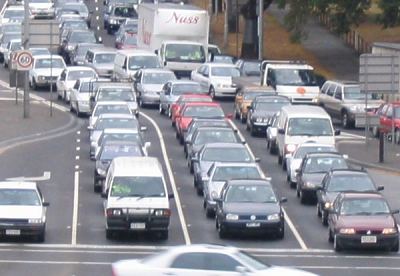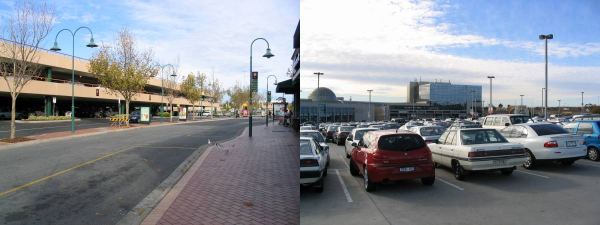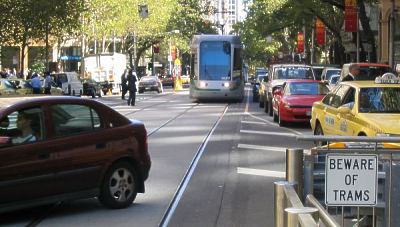Today the Kyoto protocol comes into effect, at least in the countries that have signed up to it. Of which ours isn’t one, so unlike most industrialised countries, we (along with the US and China) can blissfully keep pumping CO2 into the air, with no legal consequences.
A lot of the contributions to emissions come from motor vehicle emmissions, and with that in mind, here’s a kind of FAQ. The following is a conglomeration of a few conversations I’ve been having over the past couple of months, fictionalised, modified, merged, and with extra stuff added.
So you’re involved in the Public Transport Users Association? Why?
‘Cos I think it’s an important cause. It’s my particular interest among many green issues.

Green issues?
(One person I spoke to seemed particularly confused by the whole concept of green issues. Maybe the entire environmental movement passed him by.)
Well there’s air quality, land space (cities with all their land taken by roads aren’t very pleasant), noise pollution, as well as issues to do with health (not just car crashes, but also lack of fitness from being driven everywhere). And the bigger picture: global warming is said to have already started at such a rate that it will destroy the Great Barrier Reef, for instance. And economically, we’re going to be in big trouble if the Peak Oil predictions around petrol prices are anything near accurate.
So did you catch the train here tonight? heh. heh.
Three distinct concepts for you: Advocacy, Promotion, Martyrdom. I’m involved in advocacy.
Promotion: PT advocacy is not about nagging people to use services, particularly when they don’t exist or aren’t viable. That’s what Metlink and TravelSmart do.
Martyrdom: PT advocacy is also not about me personally using public transport all the time, even when it’s infrequent and slow.
I was asked if I’d used the train when out at dinner at Docklands and at Williamstown. In both cases, this was on nights that the trains were a complete mess after 10pm due to works at Spencer Street. From Docklands I would have had to get a shuttle bus all the way around the city before connecting with my train, which only ran every 30 minutes. From Williamstown, it would be a train trip that involved changes at Newport, Footscray, and Flinders Street — the first two with a minimum wait, but the third subject to those 30 minute trains again. It all adds up to a long trip, and unless I’m planning on drinking a lot, I’ve got no more infinite patience than anybody else. Even if they had all been running normally, they’re only every half hour. Who wants to wait half an hour in a cold dark station to get home?
Advocacy is about campaigning for better services, services that are good enough that people want to use them, and thus curb car use.
I used the tram today around the city, and it was fine.
For some trips, it is good. It’s usable. As long as the trip you’re making is parallel to a tram or train route, and you’re travelling in the day time. And you don’t mind waiting a few minutes between connections. Where it’s good, people use it, even if they have a choice.
But there are millions of untapped trips around Melbourne every day that can’t be made by public transport without sacrificing a lot of time.
This is why PT has around 7% — that’s SEVEN PERCENT — of the total share of travel around Melbourne. 9% if you only count motorised trips.
But surely public transport is just for reducing congestion in the inner suburbs?
1. Outer suburban roads are filling up, not just at the tradional commuter peak hours, but all week long. Major arterial roads like Springvale Road are traffic nightmares when they’re at their worst. This is not the inner burbs.
2. If you head over to Chadstone on any Sunday (let alone close to Christmas), you’ll find a shopping centre full of customers. And a carpark full of customers’ cars. In fact more than full, there are others circling, looking for spaces. The roads around the centre also get clogged.
One of the reasons for this is that Chadstone is served by only two bus routes on Sundays. And both of those operate less than once an hour. That’s not usable, not to anybody who values their time and has a car of their own they can use.

3. A lot of the inner suburban traffic problems are caused by people coming in from the outer suburbs. At home in Wantirna and Keysborough and Altona Meadows they have little or no usable public transport, so they’re in the habit of driving everywhere, including into the inner suburbs. Even if they have the option of catching a train in, they probably don’t want to be waiting 20 minutes for it, or 30 after dark, especially when the waiting time is probably more than the total travel time by car.
But with somewhere like Chadstone, people need to drive, to carry parcels home
Ah, but when did you last visit a shopping centre and come away with so much stuff you couldn’t carry it yourself? It’s true for some trips to shopping centres you end up with heaps of stuff, for instance a big grocery shop or an en-masse Christmas present expedition. But many trips result in minimal amounts of shopping, and are at least partially to make use of services, not shopping. Cinemas, bowling, banking, all these activities don’t end with you lugging home huge parcels.
Okay, so what’s wrong with public transport?
In off-peak hours, most of it’s too infrequent.
Trains only run every 20 minutes on weekends, many on weekdays too. Only every 30 minutes after dark. Who wants to wait an average of 15 minutes on a cold dark station platform? Nobody who has a choice. By contrast, most services are frequent enough in the traditional commuter peaks to be very popular (so popular that overcrowding is a problem).

Trams are popular and run along direct easy to understand routes, but they get caught in traffic. Turning vehicles, traffic congestion, traffic lights… all these need to be fixed. And they need to be more frequent after dark.
Buses are confusing. Most of the routes twist and turn all over the place, which is fine if you want a scenic ride, but useless for competing with car travel. Most buses don’t run at all on Sundays. Almost all those that run at all on weekends are only hourly. Most buses don’t run any kind of competitive service. Many shut down in the middle of the evening peak hour. The number of genuinely usable bus routes in Melbourne is probably less than a dozen.
For routes that are fast and direct (like trains), better frequency means more passengers. When they upgraded Sandringham line off-peak trains from every 20 minutes to 15, patronage jumped by 30%, which more than covered the additional running costs. It’s proven.
The bottom line is this: people want public transport that is fast, frequent, clean, safe and cheap.
But why oppose freeway building?
Travel is supply-led. Time and time again we’ve built freeways, only to see them fill up with cars. To which people cry “build more freeways!” And they fill up with cars too. You can’t keep doing this. Cars are simply not an efficient way of moving millions of people around cities.
The average car has 1.1 people inside it. Every time you build more road capacity, it fills with more cars holding an average 1.1 people. Every time you make it easier for people to get somewhere by car… they do.
Don’t get me wrong, I enjoy zooming along the freeway (out of peak hour). It’s a joy to get places so fast. No wonder people like them. But it encourages more and more people to travel further and further by car.
So if you want to keep car use increasing, fine, keep expanding the road system. But we don’t actually want that, do we?
The other point to make is that freeway building is notoriously expensive. The Mitcham to Frankston tollway will cost about $2.5 billion. That’s almost three times the cost of the rail project that is re-building no less than four country rail lines at the moment, and around ten times the cost of the proposed rail line from Huntingdale via Monash Uni to Rowville, which I would humbly suggest will do a great deal more to get cars off the road than the tollway.
But we need freeways for freight!
Do we? Most of the traffic on freeways is cars, not trucks. And if we do, should we build freight-only freeways? A lot of money (especially federal money) goes into paying for freeways with the idea of making freight more efficient, only to have those roads fill up with non-freight-carrying cars.
Okay, so we need better PT. Why isn’t it happening?
Primarily because we have governments at all levels that makes the right noises (like “sustainable transport” and “increase PT share to 20% of motorised trips by 2020”) but then do pretty much the opposite by burning up the transport budget building more roads. Oh, with a token improvement to PT, of course. In the case of the Mitcham to Frankston freeway, they trumpeted a few landscaping projects for railway stations and a single new bus route.
They also fail to take an overall view to solve traffic problems, even when obvious solutions that don’t require any extra infrastructure are there. When faced last year with the issue of traffic snarls around Richmond due to The Wiggles playing concerts at Rod Laver, they looked at tweaking the traffic lights in the area, but fail to address things like the local tram service being packed (you could run longer or more frequent trams) and train users having a hard time getting to the place (because the exit at Richmond Station closest to the venue wasn’t opened, making people take a 10 minute walking detour and having to cross Punt Road).
It’s not rocket science. If we want to continue to foster a livable city, good air quality, a fit population, we need to give people viable alternatives to driving their cars.
See also:
8 replies on “Kyoto, transport, all that guff”
Nicely argued. Example 1. I lived in Balaclava on the Sandringham train line when the improved service started. We started using it all the time. It was competitive against the car. Example 2. I lived in Balaclava when the route 69 tram service was reduced and became less reliable. I stopped using it to travel to work and reverted to my car.
Mixed feelings about Kyoto. It is not very ambitious, but at least it is something I suppose.
You hinted at the bigger question when you talked about more roads = more cars (in simple terms). The govt has a vested interest in cars, as it means an income stream, where PT is not, not compared to cars anyway. More cars = more taxes on vehicles, taxes on fuel, GST on servicing cars, the list goes on. Not to mention tolls! There is greater benefit to govt in keeping cars on the road than getting people on PT. Also PT projects generally take more than 4 years to complete (I’m guessing) and if they lose power at election time has no benefit. Roadworks are a pretty quick start & visible option to keep people remembering the ‘election promises’.
You’ve reminded me of the inconveniences of my public transport travel experiences when I was in first year uni and had just moved to the big smoke and didn’t yet have my P-plates or a car … I lived in Glen Waverley off High Street Rd, and had to travel to Monash Uni in Clayton. I also had a part time job at Safeway at ‘The Glen’ shopping centre. The problems? Just to name a few … I had to ask the woman I boarded with to drive me to uni on public holidays, I couldn’t really go anywhere at all on Sundays or even Saturday afternoons, and I couldn’t work any late shifts at Safeway because the last bus home (which was only a few minutes’ drive away, but a 20-30 minute walk) left at something like 7pm, even in the daylight savings period. The few times that I did get asked to stay back and couldn’t refuse (due to being a poor uni student) I had to beg the woman I lived with, or her driving son, to come and collect me. End result? I bought a car as soon as I could, and I travel on public transport fairly infrequently now (8 or so years later), even though I now live in an ‘inner’ (more or less) suburb and there is a number of bus options to get from home (Fairfield) to work (La Trobe Uni in Bundoora) …
I was late in getting my license and had to rely on PT for the first year of my uni course. It took me almost two full hours most days to get the place which was only 15km away and 10 minutes by car. A half-hour bus ride (scenic route) and a possibility of a missed train (happened 9 times out of ten) to get from W’bee to Hoppers and then the walk down to the Uni (10-15 depending on how fast I wanted to get there). If the buses and trains didn’t connect, there was often a 40 minute wait between both new trains and new buses. The W’bee buses still run on every 40 minutes -which is pretty pathetic considering they’ve “expanded” to take in the new Wyndhamvale/Wyndham Green/Manor Lakes estates.
Ahem … Altona Meadows does have *some* useable PT, in the form of a bus-to-bus connection to one of the best bus routes in Melbourne, the good ol’ 232 (Westgate bus). My husband works in Port Melbourne, and to drive there in morning peak takes an average 45 minutes. For him to catch the bus, without the stress and leaving me the car for the day (we only have one car, what a deprived family! :-), takes 55-60 minutes (the extra time is the time it takes him to walk to the first bus stop for the 415 connector bus). It usually turns up on time, it scheduled to always connect at the refinery with the 232, and that bus is almost never late or cancelled. So he can walk out the door at 7:25 and be logging on at his computer at work at 8:25. Which isn’t bad given he’s usually only 10-15 mins better off in the car.
That said, outside of peak hour, forget it, the buses are lousy. Which means that me and my toddler either drive or walk where we need to go, although I’d happily take the train / bus if doing so didn’t involve extreme risk and sacrifice of options.
Stuart, the real cost of the road system is one that is subject to current debate. Though it seems like a lot of revenue, there are huge costs in construction, maintenance, policing, road-associated medical services, and less measurable things like air pollution and quality of life, unavoidable congestion, social inequity. Obviously you need to have *a* road system, but I don’t think the maths of it continuing to expand in already developed urban areas stack up. As for projects completed in electoral terms… unless you’re doing something really big/complicated (eg the city loop) four years should be plenty. In any case in Melbourne we already have much of the infrastructure in place… we just don’t use it very well.
Kathy, I think you’ve proven my point! In fact, a quick glance at the timetable shows the 415 is uselessly infrequent unless you plan your life around it. It’s great that G can use it, but what if he’s 10 minutes late leaving the house? And how on earth does he make the connection off the (more frequent) 232 on the way home?
I’m lucky, I have worked out my morning commute so that it only takes 45 minutes by tram (No. 16 & No. 96)
When I was going to Uni at Monash Churchill it took 2 hours each way by bus (changing once) and the intertown service only ran once per hour. I completed my degree using this arrangement.
Thanks.
Kyoto: Think Globally, Act Locally
Today, the Kyoto Protocol goes into effect. Of course, President Bush declined to add the United States to the list of 141 countries ratifying the decision. USA Today reports that a number of businesses, nonprofits, and many states are already